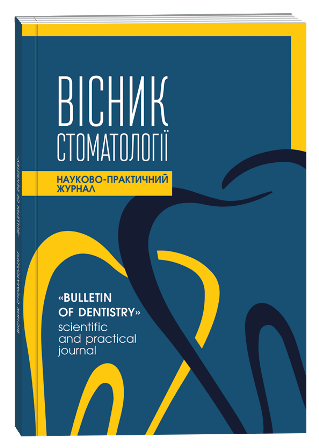ВПРОВАДЖЕННЯ CAD/CAM ТЕХНОЛОГІЙ В ОРТОПЕДИЧНІЙ СТОМАТОЛОГІЇ
DOI:
https://doi.org/10.35220/2078-8916-2024-51-1.39Ключові слова:
комп’ютерне проектування, комп’ютерне виробництво, моделювання, конструкції, 3D-сканування.Анотація
Протези, виготовлені без урахування анатомо-фізіологічних особливостей тканин ясен, здійснюють несприятливий вплив на тканини протезного ложа та посилюють атрофічні процеси. Однією з основних клінічних задач в стоматології є повноцінне відновлення функції жування за рахунок високої якості виготовлених зубних протезів. Комп’ютерні програми та технології змінили та спростили життя людини в різних галузях життя та діяльності. За останній час цифрові технології почали активно застосовувати і в реставраційній стоматології. Якщо раніше виготовленням протезів займалися в ручну, починаючи з замірів, проектування та завершуючи литтям, то зараз і моделювання, і виготовлення – автоматичні процеси, які керуються комп’ютером. І це все завдяки розробці CAD/CAM технології. CAD/CAM технології ‒ автоматизований метод виготовлення ортопедичних конструкцій. CAD/CAM системи порівняно з традиційними методами виготовлення ортопедичних конструкцій виключає помилки людського чинника, що дозволяє досягти більш швидке та точне виготовлення протезів. Технології CAD\CAM гарантує високу точність, функціональність та деталізацію анатомії зуба та прикусу пацієнта, дозволяє візуалізувати та оптимізувати дизайн та естетичні аспекти коронки перед її виготовленням. Висновок. Використання CAD/CAM-технологій в стоматології має такі переваги, як: максимальна автоматизація виробництва, висока точність і функціональність моделювання та виготовлення конструкцій з урахуванням анатомічних особливостей зубощелепної системи, уникнення блювотного рефлексу у пацієнтів, максимальна якість виконання і підвищений комфорт пацієнта, значна економія часу, уникнення потрапляння відбиткових матеріалів в дихальні шляхи. Таким чином, проаналізувавши поданий матеріал можна сказати, що ортопедичні конструкції, виготовлені за допомогою CAD/CAM- технологій, повністю відповідають вимогам, а також найбільш оптимальні в співвідношенні «якість-час». CAD/CAM-технологій дозволяє виробляти ортопедичні конструкції враховуючи індивідуальні особливості анатомії пацієнта. Таким чином, цей метод дозволяє вирішувати багато клінічних завдання, пов'язаних з протезуванням, максимально індивідуалізувати протези, зробити їх більш зручними та комфортними.
Посилання
Albuha Al-Mussawi, R. M. & Farid, F. (2016). Computer- Based Technologies in Dentistry: Types and Applications. Journal of dentistry (Tehran), 13(3), 215-222. PMID: 28392819; PMCID: PMC5376549
Alghazzawi, T. F. (2016). Advancements in CAD/ CAM technology: Options for practical implementation. Journal of Prosthodontic Research, 60 (2), 72-84. doi: 10.1016/j.jpor.2016.01.003
Amanngirrbach. Aviatable from: https://www.amanngirrbach. com/en/home/
Bidra, A. S., Taylor, T. D. & Agar, J. R. (2013). Computer-aided technology for fabricating complete dentures: systematic review of historical background, current status, and future perspectives. The Journal of Prosthetic Dentistry, 109(6), 361-366. doi: 10.1016/ S0022-3913(13)60318-2.
Chen, J., Ahmad, R., Suenaga, H., Li, W., Sasaki, K., Swain, M. & Li, Q. (2015). Shape Optimization for Additive Manufacturing of Removable Partial Dentures--A New Paradigm for Prosthetic CAD/CAM. PLoS One, 10(7), e0132552. doi: 10.1371/journal.pone.0132552. 6. Create perfectly integrated dental CAD/CAM solutions with exocad software. Aviatable from: https://exocad. com
de Mendonça, A. F., Furtado, de Mendonça, M., White, G. S., Sara, G. & Littlefair, D. (2016). Total CAD/ CAM Supported Method for Manufacturing Removable Complete Dentures. Case Reports in Dentistry 2016, 1259581. doi: 10.1155/2016/1259581.
Dental CAD/CAM Solutions. Aviatable from: https://www.3shape.com/en
Dental Wings Products and Solutions. Aviatable from: https://dentalwings.com
Dentsply Sirona is a leading supplier of professional dental products and technologies. Aviatable from.
Giordano, R. (2003). CAD/CAM: an overview of machine sandmaterials. Journal of Technologic Dentistry, 20, 20-30.
Groten, M., Girthofer, S., & Probster, L. (1997). Marginal fit consistency of copy-milled all-ceramic crowns during fabrication by light and scanning electron microscopic analysis in vitro. Journal of Oral Rehabilitation, 24(12), 871-881. doi: 10.1046/j.1365-2842.1997. 00592.x.
Hintersher, J, inventor (1994). Verfahren zur Herstellung Dental-prothesen. Europäische Patentschrift EP 0630622B1. June 23.
Liu, P. R. (2005). A panorama of dental CAD/CAM restorative systems. Compendium of Continuing Education in Dentistry, 26(7), 507-508. PMID: 16060380.
Miyazaki, T., Hotta, Y., Kunii, J., Kuriyama, S. & Tamaki, Y. (2009). A review of dental CAD/CAM: current status and future perspective from 20 years of experience. Dental Materials Journal, 28(1):44-56. doi: 10.4012/ dmj.28.44.
Mörmann, W. H. & Brandestini, M. (2006) The fundamental inventive principles of CEREC CAD/CAM. In: Mörmann, W. H. (ed.). State of the art of CADS/CAM restorations: 20 years of CEREC. London: Quintessence
Mormann, W. H. (2004). The origin of the CEREC method: a personal review of the first 5 years. International Journal of Computerized Dentistry, 7(1), 11-24. English, German. PMID: 15317305
Mormann, W. H. (2006). The evolution of the CEREC system. Journal of the American Dental Association, 137, 7S-13S. doi: 10.14219/jada.archive.2006.0398.
Patel, N. (2014). Contemporary dental CAD/CAM: modern chairside/lab applications and the future of computerized dentistry. Compendium of Continuing Education in Dentistry, 35(10):739-746; quiz 747, 756. PMID: 25454527.
Posada, M. & Nathanson, D. (2010). Marginal and internal fit of all-ceramic CAD/CAM single crown restorations. In: Conference: IADR General Session 2010, International Association of Dental Research meeting. Barcelona, Spain, Abstract 532.
Sulaiman, F., Chai, J., Jameson, L. M. & Wozniak, W. T. (1997). A comparison of the marginal fit of In-Ceram, IPS Empress and Procera crowns. International Journal of Prosthodontics, 10(5), 478-484.
Tinschert, J, Natt, G., Hassenpflug, S. & Spiekermann, H.(2004). Status of current CAD/CAM technology in dental medicine. International Journal of Computerized Dentistry, 7(1), 25-45.
Witkowski, S. (2005). CAD/CAM in dental technology. Quintessence of Dental Technology, 28, 169-184.
Young, J. M. & Altschuler, B. R. (1977). Laser holography in dentistry. Journal of Prosthetic Dentistry, 38(2), 216-225. doi: 10.1016/0022-3913(77)90289-x.









